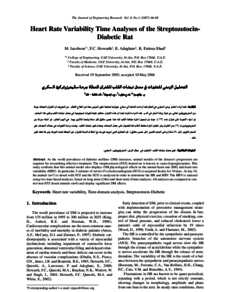Document
Heart rate variability time analyses of the streptozotocin- diabetic rat.
Contributors
Publisher
Sultan Qaboos University
Gregorian
2007
Language
English
English abstract
As the world prevalence of diabetes mellitus (DM) increases, animal models of the disease's progression are required for researching effective treatment. The streptozotocin (STZ) treated rat is known to cause hyperglycaemia. This study confirms that this animal model also displays DM physiological effects in the animal heart rate (HR) and heart rate variability (HRV). In particular, 5 minutes of rat (n=13) electrocardiogram (ECG) is acquired hourly for 30 days. At day 10, the animal (n=7) is dosed with STZ and the ECG is analyzed in order to determine the HR and HRV. The HRV is indexed using two time-based analyses, based on long-term (24hr) and short-term (5min) analyses. All analyses are compared to control non-STZ dosed animals (n=6) and display significant DM effects.
Member of
ISSN
1726-6742
Resource URL
Citation
Jacobson, M., Howarth, F. C., Adeghate, E., & Fatima-Shad, K. (2007). Heart rate variability time analyses of the streptozotocin- diabetic rat. The Journal of Engineering Research, 4 (1), 64-68.
Arabic abstract
كلما ازداد انتشار مرض السكري في العالم كلما ازدادت الحاجة إلى نماذج حيوانية لمتابعة تطور المرض بحثا عن العلاج الفعال. من المعروف أن الفئران المعطاه جرعة من الستريتوزوكين تعاني من فرط زيادة السكر في الدم. هذه الدراسة تثبت أيضا أن هذه الفئران ستظهر عليها تغيرات فسيلوجية في معدل نبضات القلب وتغير هذا المعدل. تم إجراء التجربة على فئران عدد (13)، حيث تم تسجيل إشارة مخطط القلب لها عدة خمس دقائق لكل ساعة ولمدة ثلاثين يوما. في اليوم العاشر، تم إعطاء جرعة من الستريتوزوكين ل (7) من الفئران وتم تحليل إشارة مخطط القلب لها للحصول على معدل النبضات ومعدل تغير نبضات القلب. وتمت دراسة التغيرات في معدل النبضات على المدى الطويل (كل 24 ساعة) وعلى المدى القصير (كل خمس دقائق). كل التحاليل التي أجريت قورنت مع الحالات الستة للفئران غير المعطاه لهذه الجرعة وتم ملاحظة تأثير ذلك.
Category
Journal articles

